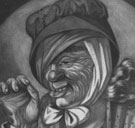> DRY
DRUNK
THE SNEEZING CURE
The finely ground powder made from leaves of tobacco and known as snuff
was, alongside smoking and chewing, one form of tobacco consumption common
among certain groups of Amerindians before the arrival of the Europeans.
Although it received some mention in the 16th and early 17th centuries, its
use was largely restricted to Spain and France until the final quarter of
the 17th century. According to some accounts, Catherine de' Medici, Queen
Mother of France, imbibed snuff as a cure for headaches at the behest of
Jean Nicot, the royal ambassador to Portugal; some even said she invented
the powdery concoction, though there is little to support that claim. A more
verifiable early mention of snuff is Pope Urban VIII's 1642 bull forbidding
tobacco consumption in the churches of Seville (Spain), in response to complaints
that both laypersons and clergy were smoking and snuffing not just in church,
but during High Mass. It was the French court, however, that eventually popularized
snuff, to the pleasure of some and the chagrin of others, including the King.
Things French were synonymous throughout Europe with high fashion at the
time, so it comes as no surprise that by 1700 the taking of snuff, which
was generally mixed with other fragrant herbs and spices, rivaled pipe-smoking
as the most popular form of tobacco intake throughout Europe.
Snuff, like other tobacco preparations, also claimed its share of medical
miracles, and was declared capable of curing, or at least relieving the symptoms
of, a long inventory of ailments. The same range of characters who smoked
pipes were represented using snuff, so that while it had connotations of
high sophistication in some quarters, it was also enjoyed by old biddies
in the street
86
Karel van Mander (Dutch, 1610–1670)
Lauwercrants/ Voor alle Lieffhebbers des Loffwaerden Snuyfftoebacks.
Als oock Haer Gheboort, ende hooghe Hercomst [Laurel wreath for all amateurs
of the honorable snuff tobacco. In addition, her lofty origins]
N.p., 1665
Arents Tobacco Collection
In a new twist on the story of the mythological origins of tobacco and
Olympian dislike of smoke, the goddess Pallas proclaims that tobacco is
the divine herb that had been prophesied: pulverizing the leaves, she produces
snuff, which is then disseminated all over the earth. Van Mander (the son
of the more famous early chronicler of Dutch art) calls snuff a friend
of the Muses, a soul-baring friend, a sense-sharpening pastime, a mind-tickling
pleasure, oil in the brainworks, a friend of good thoughts, and an igniter
of invention.
87
Louis Ferrant (French, 17th century)
Traicté du Tabac, en Sternutatoire [Treatise on tobacco as a
sternutatory]
Bourges: the widow and Jean Toubeau, 1655
Arents Tobacco Collection
In this first book on snuff tobacco, the author praises tobacco as an
excellent "cephalic purge" –sneezing for health. Ferrant, whose preface
is addressed "to those who love their health," assures the reader that
using tobacco in this way would not cause memory loss, "since the humors
purged by snuff do not affect the seat of reason."
88
Francis Grose (British, 1731?–1791)
A Guide to Health, Beauty, Riches, and Honour
London: Hooper and Wigstead, 1796
Print Collection
In this advertisement for his "Imperial Snuff" for all disorders in
the head, body, and mind, Samuel Major expresses the modest hope that users
of his product will at least experience relief, if not a cure.
89
Unidentified (French, last quarter 18th century)
Dugazon, dans Sganarelle du Festin de Pierre, Acte I, Scène
I [Dugazon, as Sganarelle in Don Juan, or the Festin de Pierre by Molière,
Act I, Scene I]
Hand-colored etching and engraving in: Petite Galerie Dramatique, ou Recueil
de différentes Costumes d'Acteurs des Théatres de la Capitale
[Small dramatic gallery, or Collection of various actors' costumes from the
theatres of the capital], vol. I. Paris: Martinet, 1790
Print Collection, Cadwalader Fund
 Molière's 1665 play, Don Juan, opens with Sganarelle, a snuff
box in his hand, singing the praises of tobacco:
Molière's 1665 play, Don Juan, opens with Sganarelle, a snuff
box in his hand, singing the praises of tobacco:
Whatever Aristotle and all of philosophy might say, there is
nothing to equal tobacco: it is the passion of honest people, and he who
lives without tobacco is not worthy of living. Not only does it rejuvenate
and purge the human brain, but it also instructs the soul on virtue, and
teaches one to become an honest man. . . .
He reasons that it has this effect of making one honest because, once you begin
taking it, you start passing it around to everyone, even before they ask. "But
that is enough of this matter . . .," and the play begins.
90
Unidentified (British, 1st quarter 18th century)
Snuff and Twopenny
Mezzotint, n.d.
Arents Tobacco Collection


